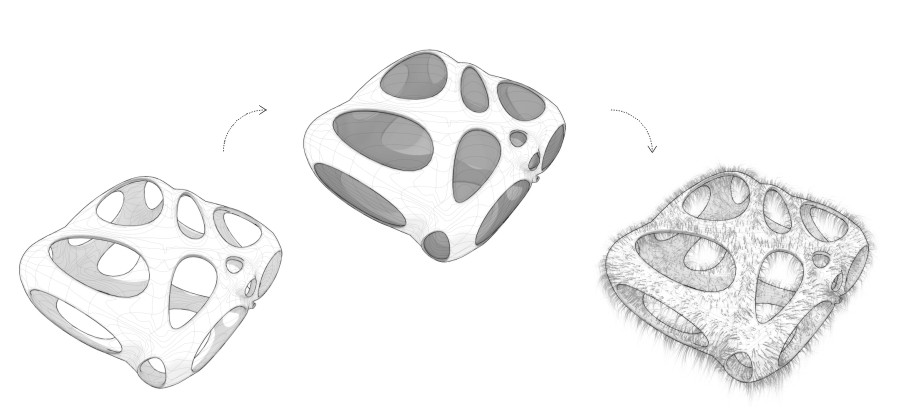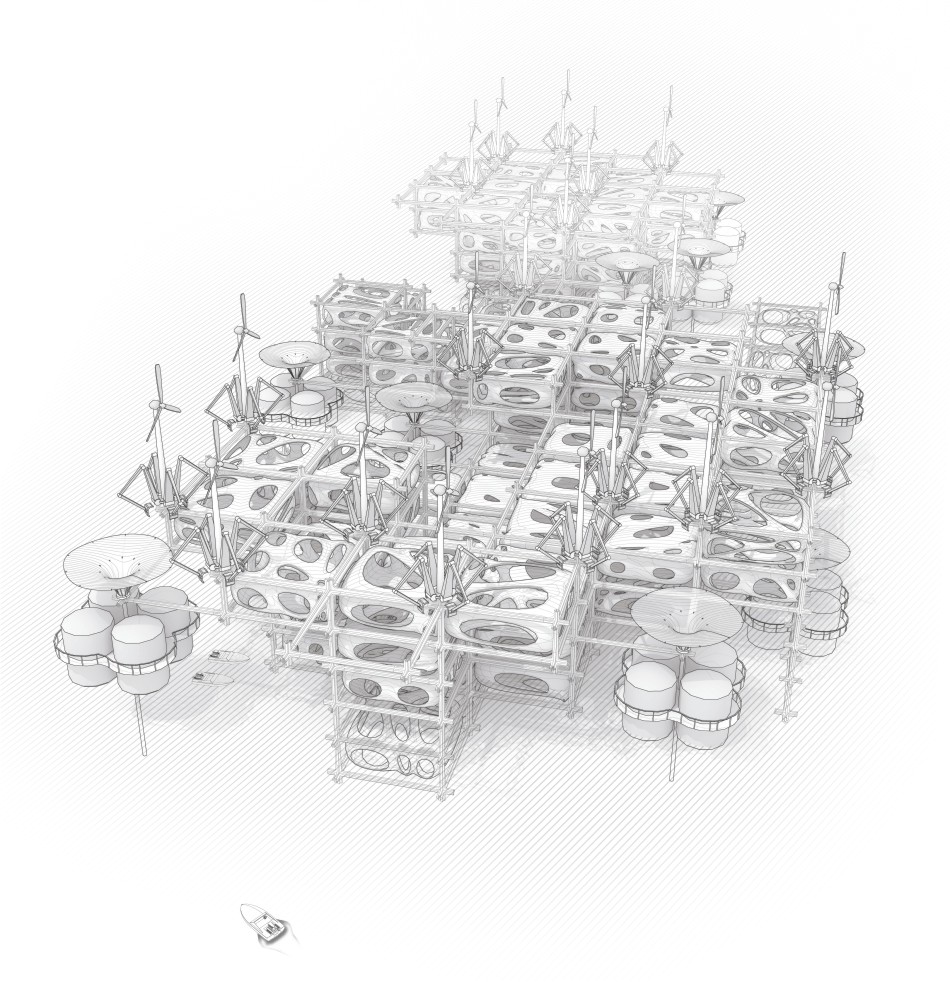Protocol Infrastructure attempts to approach the design of infrastructure in an alternative, bottom-up fashion, that is not based on master planning but instead on the development of a protocol that would allow infrastructure to ‘self-organize’, adapting at the same time to the conditions that it encounters. The characteristics of such an approach are illustrated through the example of a structure, designed for the San Francisco Bay, which aims to the development of a system that would allow for a settlement to face the rising of the water level because of global warming. The model proposed, instead of following a ‘long term’ plan adapts itself to the situation that it encounters (water level, population needs) and grows in height following an algorithm designed for that reason. Machines are used from the system as the agents that would allow self organization to happen and the means to build the structure.
The protocol functions as the framework – which incorporates both a predefined growth algorithm and the ability to receive input from its environment – that would allow for the model to develop itself according to the needs that it encounters. That process results in a system where the final result cannot be predicted and is able to ‘answer’ to an array of extremely different conditions that it may encounter. Bottom-up, protocol-based infrastructure would be always a result of the exact conditions that it has to serve.

Software and software development tools can be understood as part of infrastructure, to the extent that they help in the function or planning of that infrastructure. For example, a software that calculates estimated future sea level is an integral part of the infrastructure necessary to face the problem. However, in the context of a distributed infrastructure, one that self-organizes and adapts to the situations that it encounters, the relation of software to infrastructure can be inverted. Instead of software just being part of an infrastructural system, in the case of a bottom-up model we are in need of software that generates the infrastructure. In other words, we need software, or an algorithm, that will be applying the transition function each time that the model needs to change stage. Therefore software that would incorporate the rules defining the interaction between the elements of the system and that at the same time would be able of receiving input concerning the conditions that the system encounters. In that line of thought a computer program is developed in order for the proposed growth model to be visualized and tested. The software incorporates all the conventions specified by the protocol, the core being a cellular automaton algorithm controlling the growth according to the relationships between the cell and the ability to receive external input that will allow for the model to be aware of its environment.
 |
 |
The construction of the system is totally mechanized, allowing for the process to be automated. Machines, controlled by the software, are integral part of the system and the means for the creation of the structure. Automation is an important aspect since it is necessary in order for the system to be able to self-organize. The machines become the agents in the process of self-organization and agents are the ‘moving’ factor, the ones that set the system in motion. In self-organized systems in general, an agent “is processing an input to produce an output” and therefore from an input state is being processed to produce an output state. “The input state is determined by the immediate environment of the agent, and the output state determines the agent’s effect on it’s immediate environment” (Holland, 1999). That is also exactly the function of the machines in the growth of the system: They are equipped with a basic or primitive form of artificial intelligence, that is, being able to record the state of each cell, calculate the next state of the system and define collectively the routes that have to be followed in order for the structure to be build. The machines are the ‘bearers’ of the generative algorithm and their actions are defined precisely by the designed protocol. It is the machines that the protocol is controlling, however the control is not central but local. Each machine moves and acts individually according to that protocol and it reacts with the other machines in modes defined by the protocol.




References:
Holland, John H. Emergence New York: Basic Books, 1999.
| >>info: | |
| research: | Dimitris Gourdoukis |
| date: | 2009 |
| publications: | — D. Gourdoukis “Agile Computation or Manifesto for Agile Architecture Development” στο Tellios, A. (ed) Agile Design. Advanced Architectural Cultures Thessaloniki: CND Publications, 2014. — Gourdoukis, D. “Protocol Architecture” in Marinic, G., Schlachter, M. (eds) d3:dialog>assemble (is. 1) New York: d3, May 2011. — Watson, D., Adams, M. (eds) “Design for Flooding: Architecture, Landscape, and Urban Design for Resilience to Climate Change.” New York: John Wiley, 2011. — Gourdoukis, D. “Protocol Growth. Development of Adaptable City Models through Self-Organization” in Future Cities, ETH, Zurich: 2010. |
| exhibitions | — Rising Tides Exhibition at San Francisco Ferry Building. July 10th to July 19th, 2009. |
